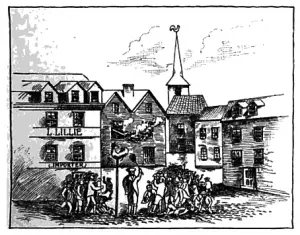Christopher Seider: The First Casualty in the American Revolutionary Cause - New England Historical Society (original) (raw)
12K
Christopher Seider was just 11 in 1770, a working boy in Boston at a time when the city was awash in the debate over the Massachusetts colony’s relationship with Great Britain.
 In 1770, the American colonies strongly resisted the British Townshend Acts. The Acts taxed goods such as lead, paper tea, paint and glass. However, the desire for British goods was also strong.
In 1770, the American colonies strongly resisted the British Townshend Acts. The Acts taxed goods such as lead, paper tea, paint and glass. However, the desire for British goods was also strong.
American-made clothing and other products were often rougher in appearance and less appealing. Some goods could only be had by importing them.
Non-Importation Agreements
Boston merchants had agreed to boycott British goods to protest the tax. But throughout the colony, people wondered whether they’d continue to honor non-importation agreements. Boston had played a leading role in implementing the non-importation strategy and convincing other colonies to join in. But the cost took its toll.
Frustrated by several years of struggling to make a profit, the stage was set for merchants to announce they would no longer honor non-importation agreements and would resume selling British goods.
Theophilus Lillie, a dry goods merchant, was one of the earliest to break the non-importation agreements. Though some merchants disregarded the ban altogether, most did it quietly. Lillie, though not political, did so with a flourish, announcing his intentions in a letter to the Boston Chronicle.
His decision led to dueling letters and articles in the newspapers and, on the night of February 22, a protest in front of his house.
Importer
“A number of boys had been diverting themselves with the exhibition of a piece of pageantry near the house of Theophilus Lillie,” the Boston-Gazette and Country Journal reported. They placed a sign, ‘IMPORTER,’ in front of his home.
Soon their protest turned explosive. Ebenezer Richardson, a British customs officer, stepped in and tried to stop the demonstration. He urged several passing men to tear down the sign and effigies in front of Lillis’ house.
The passersby declined to help, and the protesters drove back Richardson and pelted him with dirt and stones as he fled. But the crowd pursued him to his house.
Richardson went to a window and first fired his musket without shot to disperse the crowd. He returned to the window to shoot again — this time his gun loaded with “swan shot,” pea-sized lead balls.

Paul Revere’s famous engraving of the Boston massacre. In the background on the right a gun can be seen firing from a window, an oblique reference to Seider’s death.
Christopher Seider
The shot injured teenager Samuel Gore, but it killed 11-year-old Christopher Seider, the blast striking him in the chest.
The news raced through the city, with newspapers halting their presses to include accounts of the shooting. Later they would report more than 1,000 people attended his funeral procession days later, which started at Boston’s Liberty Tree. Poet Phillis Wheatley would also memorialize him in a poem.
“It is hoped the unexpected and melancholy death of young (Seider) will be a means for the future of preventing any, but more especially the soldiery, from being too free in the use of their instruments of death,” the Boston-Gazette, and Country Journal opined. However, 11 days later the Boston Massacre would take place and the march to Revolution continued.
As for Richardson, he was tried and convicted of killing Seider and imprisoned for a time, but was later pardoned by the king and offered a post in Philadelphia in 1773. In that city, publishers attacked Richardson with a broadside and spread the story that he had fathered a child out of wedlock. They said he allowed a Woburn pastor to take the blame for it.
Richardson, widely reviled, would later flee to England.
This story was updated in 2022.